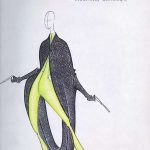1989
MAISON MARTIN MARGIELA
After graduation in 1980 he worked as a freelance designer for five years. His first attempt to penetrate the international market was made as one of a group of six graduates of Antwerp’s Royal Academy of Art. Soon, Margiela stood out as the leading light of the Belgian school. After the success of the Japanese designers in seventies, it was the Belgians who internationalized fashion design, promulgating their avant-garde vision around the world, revolting against the luxurious fashion world with garments of oversized proportions such as long arms, and with linings, seams and hems on the outside. The concept of deconstruction, also embraced by the aforementioned Rei Kawakubo, is important for the understanding of Martin Margiela’s fashion statement. Margiela famously redesigns by hand objects such as old wigs, canvases and silk scarves into couture garments.
Between 1985 and 1987 he worked for Jean Paul Gaultier, before showing his first collection under his own label, Maison Martin Margiela, in 1989. The same year, he is the first fellowship winner of ANDAM.
Between 1997 to 2003 he became, despite his non-traditional design, the creative director of the Hermès women’s line.
1999 is marked by the launch of a men’s collection called “10”, a mysterious title in keeping with the image of this celebrity with the unknown face.
Margiela’s brand is acquired by the Diesel brand in 2002 which helped its international development – with new boutiques in Tokyo, Paris, New York… – and the creation of complementary lines – 2005, men and women accessorie line, in 2007, sunglasses line, …-. The first Margiela fragrance “Untitled” is launched in collaboration with L’Oréal in 2010.
Martin Margiela introduced a new aesthetic that foreshadowed the trends of the nineties, shaking up the fashion system and redefining its principles of communication. His more-than-meets-the-eye ” approach was the opposite of the “show off” attitude of the previous decade. Starting from the premise of recycling old garments, he deconstructs them to restyle them: the outer fabric and the lining are separated to become vest and dress; a patchwork of old scarves forms a pareu to be worn over jeans transformed into skirts or painted white; a jumper is made out of army socks and dresses out of taped-together plastic slipcovers, all with an economy of means which evokes the deprivations of wartime and depression. Margiela dares to include in his collections copies of old clothes with their origin indicated on the label (a rare forthrightness in a profession in which many designers find their inspiration at the flea market but neglect to mention it). But his suits, jackets and coats also show his capacity to rethink a garment’s structure without any external references. He is also a proponent of the poetry of the unfinished. Art Press magazine quotes him as saying, “I love fashion when it is still in the sketch stage”.



